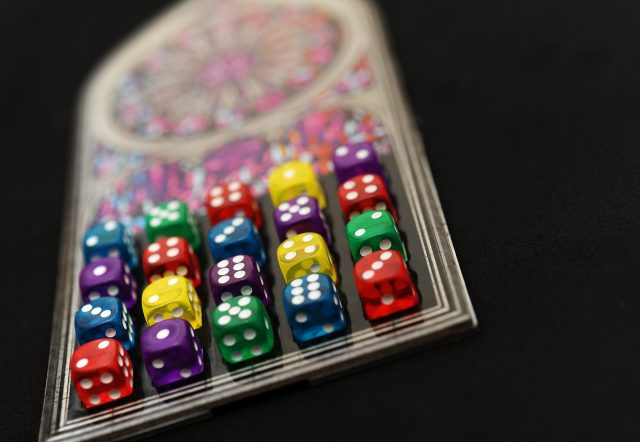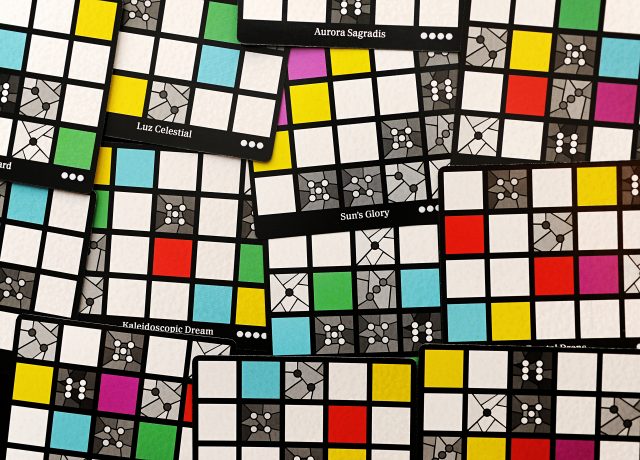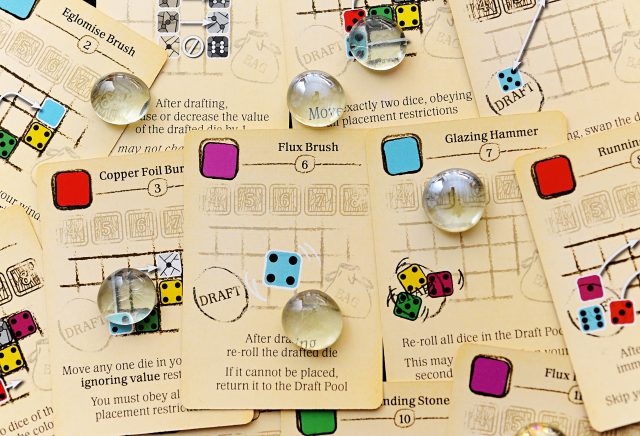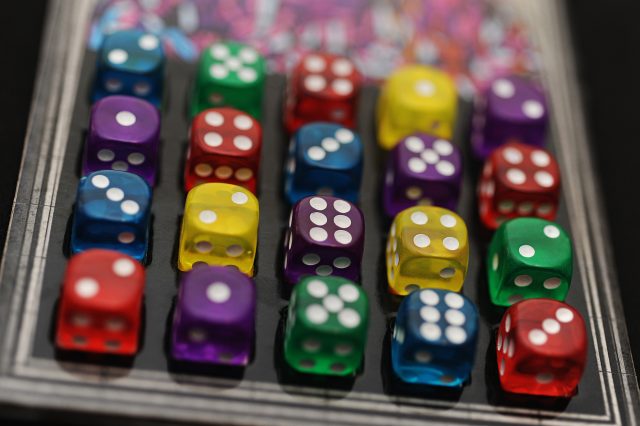The construction of one of the most famous churches in the world, the Sagrada Familia, began in Barcelona, in 1882. Although the basilica is most often attributed to the Spanish architect Antoni Gaudi, it was actually started by Francesco de Paula del Villar, before Gaudi took over a year later. The Sagrada is often referred to as the unfinished church as Gaudi died before it was completed. Now, you have a chance to complete the work yourself…at least the windows.
 Sagrada, by Daryl Andrews and Adrian Adamescu came out last year to pretty universal acclaim. It was a breakout title for the two designers. In Sagrada, 2 to 4 players draft dice over 10 rounds to fill in the grid of their stained glass window. The one who makes the most beautiful tribute to god and (more importantly) earns the most points wins the game, and presumably earns a lot of future window contracts.
Sagrada, by Daryl Andrews and Adrian Adamescu came out last year to pretty universal acclaim. It was a breakout title for the two designers. In Sagrada, 2 to 4 players draft dice over 10 rounds to fill in the grid of their stained glass window. The one who makes the most beautiful tribute to god and (more importantly) earns the most points wins the game, and presumably earns a lot of future window contracts.
The game begins with players being dealt two different double-sided Window Patterns. They are ranked in difficulty from 3 to 5. Of the four available Patterns, everyone chooses one and slides it into their window frame. They then take Favor tokens equal to the difficulty of their template.
The Patterns give players some restrictions on how the stained glass is placed in their windows, but that’s just some of the considerations they’ll have to keep in mind. Patterns will indicate that a certain number or colour of dice has to be placed in that part of the window. The standard rules for placement forbid a player from placing the same number or colour of dice orthogonally adjacent to each other.
 The first die placed in your window can go anywhere, but after that, each new one must be orthogonally adjacent to a previously placed die. In the early going, that’s not too tough, but boy those later rounds can get tricky.
The first die placed in your window can go anywhere, but after that, each new one must be orthogonally adjacent to a previously placed die. In the early going, that’s not too tough, but boy those later rounds can get tricky.
Making the decisions even harder, there are secret and public goal cards that players will complete to earn end game points. They can encourage you to go after a certain colour, even if it’s not the easiest to place in your window, or to place a number in a row or column in the hopes it will earn end game points.
Each round, the start player will draw dice from a bag equal to twice the players plus one. They roll them and then select one to add to their Pattern. Turns continue in clockwise order to the last player. They select two dice and then turn order reverses to the start player. Going first means you get you first pick of the dice, but then you’re stuck with the leftovers. There is always one die left over, which will go on the round track to mark your progress through the game.
Now, life as an artist having to follow all of these rules can be pretty tough. So luckily there is some help to be had for aspiring talents. At the start of the game, three tool cards are revealed, which can be used by any of the players on their turn…for a cost. Remember those Favor tokens you got based on the difficulty of your Pattern? Here’s where they come into play. Taking advantage of one of the tools costs you one Favor token, if you’re the first one to use it. Otherwise, it costs two to use the tools. Using them early will allow you to get them at a discount, but saving your Favors for later in the game is never a bad idea.
 The tools can allow you to do things like change the pips on a dice, or move some of the glass already placed in your window, or even allow you to take two turns in a row. Each of them is powerful, and you have to decide when is the right time to tap into them.
The tools can allow you to do things like change the pips on a dice, or move some of the glass already placed in your window, or even allow you to take two turns in a row. Each of them is powerful, and you have to decide when is the right time to tap into them.
I have to mention what a beautiful game Sagrada is. The translucent coloured dice make some darn pretty windows. The Window frames are lovely. The Tool cards have a sort of blueprint feel to them. Even the Pattern cards are pretty, without distracting you from your goals.
Sagrada is super fun and surprisingly tense for a game that is about designing stained glass windows. It’s agony to see the dice you need to complete certain goals, and have to wait and hope they’ll still be around for your next turn. You may even end up in a position where you can’t take any of the available dice, and then you have nothing to do but pass your turn. Which obviously stinks.
 Sagrada gets compared favourably quite often with Azul, another title about collecting artistic pieces and creating patterns. I have to say, I certainly love both games and have them both in my collection. I will note that with the variety of Pattern cards to choose from, the different public goals that will show up, and the Tools that will change every game, I think there may be a lot more replayability in Sagrada. Either way, you can’t go wrong with either title or both if you’re fancy.
Sagrada gets compared favourably quite often with Azul, another title about collecting artistic pieces and creating patterns. I have to say, I certainly love both games and have them both in my collection. I will note that with the variety of Pattern cards to choose from, the different public goals that will show up, and the Tools that will change every game, I think there may be a lot more replayability in Sagrada. Either way, you can’t go wrong with either title or both if you’re fancy.
Sagrada is one of those new style of puzzle games that is fun, addictive, and simple all at the same time. I never would’ve thought a game with such an unassuming theme would be getting to the table for me so often. I can’t recommend this title enough!
Comments
No comments yet! Be the first!